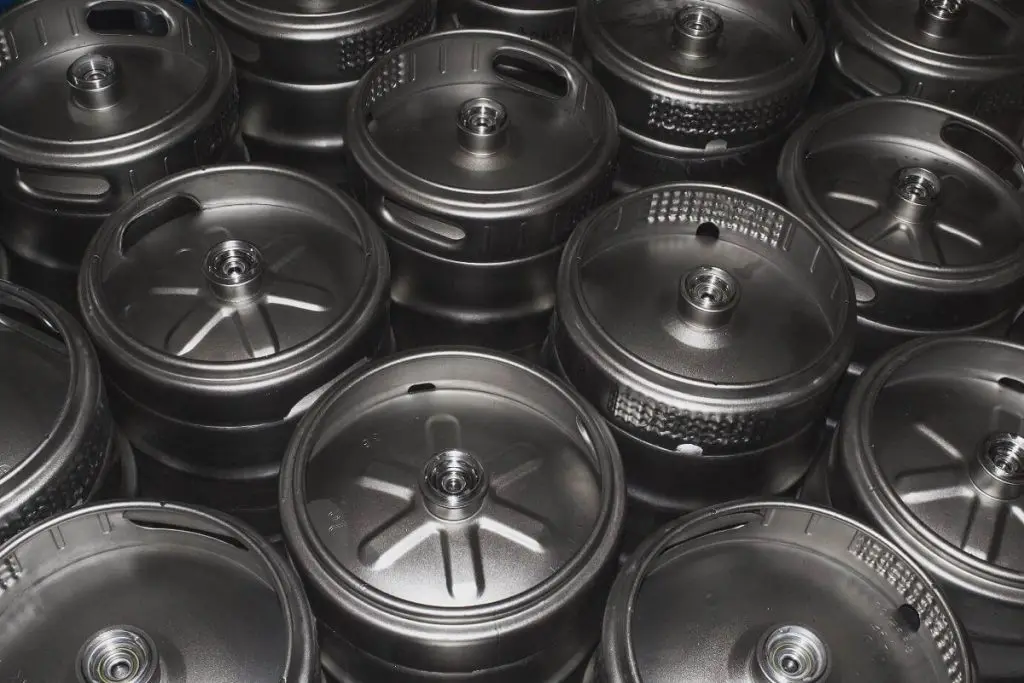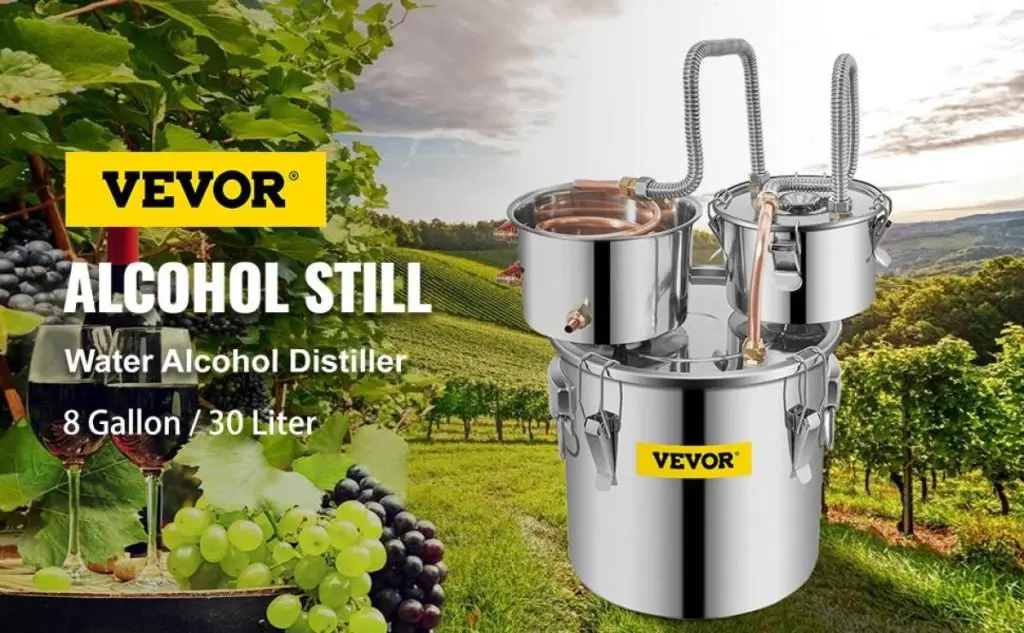The size of a keg depends on some important factors, such as Keg material, keg size, and fill level. Kegs made of aluminum are comparatively lighter than stainless steel ones, although steel-made kegs are more common. The thickness of the steel used also contributes to its weight. Then there is the capacity of a keg—that is, how much beer a keg can store. It also contributes to its weight. Lastly, we have the fill level. It is the level to which you’d fill a keg—it also determines a keg’s weight.
We said too much, right? Don’t get confused. In this article, we will talk about the keg types, the differences between them, their uses, and most importantly “how much does a keg weigh?”
Table of contents
How Much Does a Keg Weigh?
The weight of a keg depends on both its size and how much beer it holds. The most common keg size, the half-barrel, weighs around 160 pounds when full of beer but only 30 pounds empty. This is because a significant portion of the weight comes from the beer itself, with a full half-barrel containing roughly 130 pounds of beverage.
Similar trends hold true for other keg sizes. For example, a sixth barrel keg weighs around 58-60 pounds when full and 14-15 pounds empty. As we discussed in the introduction, both the size and fullness of the keg are important factors to consider when determining its weight.
Let’s discuss more in the types of kegs.
Types of Kegs
Since kegs come in various sizes and cater to different uses and user preferences, let’s take a closer look at the different keg types. First up is…
1. Full Keg AKA Half Keg
Full kegs are commonly used in bars and commercial breweries, as it has a size that can serve a large amount of people at once. And given its size, it is not usually preferred for smaller parties or gatherings. It has much of a traditional U.S. barrel type of shape but it cannot be called a barrel.
A full keg is commonly known as “half keg.” Ironical, no? Yes. But the reason behind its name is not technical at all; rather, it is historical. Since it can store around half of the beer traditional barrels in the US can store, hence its name of “half keg.”
So, how much does a full keg weigh? A full keg weighs 161.5 pounds, and can store 15.5 gallons. The weight of an empty keg is 29.7 pounds, with a height of 23.3 inches, and the beer weight can go up to 131.8 pounds.
It requires a kegerator coupler for connection and a kegerator for dispensing. Speaking of the perfect kegerator for this keg, consider VEVOR’s Full Size Beer Kegerator. It can hold one full-size 15.5 gal keg, one 7.75 gal quarter barrel, or two 5.17 gal sixth barrels.

2. 50L AKA Euro Keg
After the half-keg, we have the 50L keg. Also known as a Euro keg or European lager keg, it is widely used in Europe and other parts of the world. It’s nearly identical in size and function to the American half keg, with a negligible difference in capacity. Like its American counterpart, the Euro Keg is also a popular choice for commercial settings like bars and restaurants due to their wide availability, reusability, and cost-efficiency over time.
However, for personal use, the 50L keg’s weight can be a drawback. While empty, it weighs 27 pounds. When filled with 13.2 gallons (roughly 103 pounds) of beer, the total weight reaches 130 pounds. This can make transporting and maneuvering the keg a challenge in home settings.
But if you are someone who frequently plans large parties, you can consider this.
Like the half keg, the 50L keg uses a standard kegerator coupler for connection and a kegerator for dispensing—you can enjoy fresh draft beer at home.
3. Quarter Barrel Keg AKA Pony Keg
The quarter barrel keg, also known as a pony keg, is a good choice for homebrewers and for serving beer at house parties and gatherings. At 25 pounds empty and 88-90 pounds full, it holds approximately 7.75 gallons of beer, which is enough to serve a good-sized party. Additionally, pony kegs are generally cheaper than their larger counterparts.
Its smaller size, typically around 7.75 gallons, makes it more manageable for personal use compared to the larger half keg or 50L keg. This means both easier transportation and handling, especially when the keg is full. Also, pony kegs are generally less expensive than their larger counterparts.
For connecting the pony keg to a kegerator or party pump (both methods are compatible), a D system coupler is used. While party pumps can be a budget-friendly option for dispensing, keep in mind that they don’t maintain consistent pressure or cool the beer as effectively as a kegerator. This can lead to faster spoilage and less desirable foam characteristics.
4. Sixth Barrel Keg
The sixth barrel keg, also known as a sixtel, is a smaller keg size commonly used in commercial breweries. It weighs 16.5 pounds when empty and 58 pounds when full. Its compact size allows brewers to experiment with new recipes or seasonal offerings without committing to a larger volume. This helps minimize waste and allows for quicker taste testing.
While the sixth barrel keg is space-saving, it’s generally not recommended for personal use. Availability for purchase can be limited outside of commercial settings, and it requires a specific coupler for dispensing, different from those used for larger kegs.
However, sixth barrel kegs do have a place in some bars and restaurants. They’re ideal for offering smaller pours of less commonly requested beers.
5. Cornelius Keg
The Cornelius keg, also known as a Corny keg, is a compact and versatile option ideal for homebrewers and small gatherings. Unlike traditional kegs with a bulky, barrel-shaped design, Cornelius kegs are tall and cylindrical, making them easier to transport and store.
Weighing only 10.5 pounds empty and 55 pounds full, Cornelius kegs are significantly lighter than pony kegs. This, combined with their size, enhances their portability for home use. Another advantage is their versatility. Cornelius kegs can hold not only beer, but also soda, cold brew coffee, and other carbonated beverages. Plus, they’re known for being easy to clean and maintain, minimizing waste.
For dispensing Cornelius kegs, you can use either a kegerator for optimal freshness and pressure control, or a party pump for a more portable option. However, it’s important to remember that party pumps can accelerate spoilage, so a kegerator is recommended for longer storage of beer.
Beer Kegerator to Keep Your Beer Fresh And Carbonated
For those unfamiliar with the term, a kegerator is essentially a specialized refrigerator designed specifically for kegs. They function similarly to your standard fridge, but with features optimized for maintaining ideal temperatures and pressure for perfect draft beer.
Wondering why you might need a kegerator? It all boils down to preserving your beer’s freshness and enjoying that delicious draft experience at home. With a kegerator, you can store your keg for weeks, allowing you to extend the enjoyment beyond a single party. This offers both cost-effectiveness and convenience.
Why Prefer VEVOR Beer Kegerators?
VEVOR kegerators are designed to provide a convenient and enjoyable home draft experience. They prioritize keeping your beer fresh and delivering that satisfying chilled taste. Here’s how they achieve this:

- Optimal Temperature Control—Vevor kegerators feature digital temperature control panels, so you can precisely set the ideal temperature for your beer.
- Space-Saving Design—Vevor keeps the CO2 tank outside the kegerator. So, more internal space for keg storage.
- Enhanced Convenience—Vevor kegerators come equipped with user-friendly features like a tap beer tower for easy pouring, a beer line, and a CO2 tank, along with an installation kit for a smooth setup process. Additionally, an LED light illuminates the inside for easy access, even in low-light environments.
- Cleanliness and Safety—our kegerators prioritize hygiene with a drip tray and stainless steel guard rail to catch spills and maintain a clean dispensing area.
For added peace of mind, Vevor offers free delivery on their kegerators and a 30-day return policy—so, you can try the product with confidence.
FAQs About Keg Weights
How much does a kegerator weigh?
Kegerator weight depends on size:
- Small (1-tap): 35-55 kg (77-121 lbs)
- Medium (2-tap): 55-75 kg (121-165 lbs)
- Large (3+ taps): 75+ kg (165+ lbs)
Is a keg cheaper than cans?
Kegs are cheaper per ounce but for big parties only. They require a kegerator (extra cost) and quick consumption. Cans are better for smaller groups or if you don’t have a kegerator. To make the right call, think about cost per ounce vs. upfront cost (keg+deposit+kegerator) and how much beer you’ll drink.
How long does a keg last in the kegerator?
Keg freshness in a kegerator depends on pasteurization (lasting longer for pasteurized beers) and style (dark beers are better). Expect 2-6 months with proper storage and cleaning. Check the fill date and finish the keg quickly for optimal flavor. Brewer recommendations are best for specific kegs.
How much does a kegerator weigh in KG?
Keg weight depends on size and fullness. A standard full half-barrel keg, most common at bars, weighs around 73 kg. Sixth-barrel kegs, common for craft beers, are lighter at about 26 kg. These are averages, and actual weight can vary.
Conclusion
The weight of a keg can vary significantly depending on its size and whether it’s full or empty. Generally, kegs range in weight from light and portable options to sizes that are more substantial and require extra muscle to move around.In order to choose the right keg for your needs, consider the number of people you’re serving and the ease of transport and storage. And for storing and dispensing your keg, consider Vevor kegerators—we offer a wide range of models to accommodate different keg sizes.





